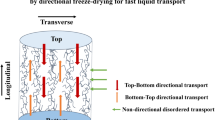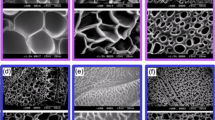Abstract
The rheological behavior of 2,2,6,6-tetramethylpiperidine-1-oxyl (TEMPO)-oxidized nanofibrillated cellulose (NFC) suspensions at different concentrations were examined using Couette with smooth and serrated surfaces and vane-in-cup geometries. A slippage against the walls of rheometer rotor or/and stator (wall-slip) as well as flow localization within a specific volume of the sample (shear banding) took place. These phenomena were visualized using a technique based on introduction of titanium dioxide pigment into the specific volume of NFC suspension and monitoring its deformation. The flow instabilities appeared more pronounced with an increase of the NFC concentration. It was shown that the use of serrated geometry is necessary to compete with the wall-slip but is not sufficient to prevent it completely. Serrated Couette was found to be the most appropriate geometry (among the tested) to measure the rheological properties of NFC suspensions. Small-angle X-ray scattering was used to provide a supplementary information about the structural organization of NFC suspensions. The statistical average diameter of 4.8 nm was determined from the scattering data for the NFC swollen in water.









Similar content being viewed by others
References
Agoda-Tandjawa G, Durand S, Berot S, Blassel C, Gaillard C, Garnier C, Doublier JL (2010) Rheological characterization of microfibrillated cellulose suspensions after freezing. Carbohydr Polym 80:677–686. doi:10.1016/j.carbpol.2009.11.045
Baravian C, Lalante A, Parker A (2002) Vane rheometry with a large, finite gap. Appl Rheol 12:81–87. doi:10.3933/ApplRheol-12-81
Beaucage G (1995) Approximations leading to a unified exponential/power-law approach to small-angle scattering. J Appl Cryst 28:717–728. doi:10.1107/S0021889895005292
Beaucage G (1996) Small-angle scattering from polymeric mass fractals of arbitrary mass-fractal dimension. J Appl Cryst 29:134–146. doi:10.1107/S0021889895011605
Beaucage G (2012) Combined small-angle scattering for characterization of hierarchically structured polymer systems over nano-to-micron meter: part II theory. In: Matyjaszewski K, Möller M (eds) Polymer science: a comprehensive reference, vol 2. Elsevier BV, Amsterdam, pp 399–409
Beaumont J, Louvet N, Divoux T, Fardin M-A, Bodiguel H, Lerouge S, Manneville S, Colin A (2013) Turbulent flows in highly elastic wormlike micelles. Soft Matter 9:735. doi:10.1039/c2sm26760h
Benhamou K, Dufresne A, Magnin A, Mortha G, Kaddami H (2014) Control of size and viscoelastic properties of nanofibrillated cellulose from palm tree by varying the TEMPO-mediated oxidation time. Carbohydr Polym 99:74–83. doi:10.1016/j.carbpol.2013.08.032
Besbes I, Magnin A, Boufi S (2011) Rheological behavior of nanofibrillated cellulose/acrylic polymer nanocomposites: effect of melt extrusion. Polym Compos 32:2070–2075. doi:10.1002/pc.21232
Bonini C, Heux L, Cavaillé J-Y, Lindner P, Dewhurst C, Terech P (2002) Rodlike cellulose whiskers coated with surfactant: a small-angle neutron scattering characterization. Langmuir 18:3311–3314. doi:10.1021/la015511t
Charani PR, Dehghani-Firouzabadi M, Afra E, Shakeri A (2013) Rheological characterization of high concentrated MFC gel from kenaf unbleached pulp. Cellulose 20:727–740. doi:10.1007/s10570-013-9862-1
Ehmann HMA, Spirk S, Doliška A et al (2013) Generalized indirect Fourier transformation as a valuable tool for the structural characterization of aqueous nanocrystalline cellulose suspensions by small angle X-ray scattering. Langmuir 29:3740–3748. doi:10.1021/la303122b
Elazzouzi-Hafraoui S, Nishiyama Y, Putaux J-L, Heux L, Dubreuil F, Rochas C (2008) The shape and size distribution of crystalline nanoparticles prepared by acid hydrolysis of native cellulose. Biomacromolecules 9:57–65. doi:10.1021/bm700769p
Estellé P, Lanos C, Perrot A, Amziane S (2008) Processing the vane shear flow data from Couette analogy. Appl Rheol 18:34037–34481. doi:10.3933/ApplRheol-18-34037
Fritz G, Bergmann A, Glatter O (2000) Evaluation of small-angle scattering data of charged particles using the generalized indirect Fourier transformation technique. J Chem Phys 113:9733–9740. doi:10.1063/1.1321770
Glatter O, Kratky O (1982) Small-angle X-ray scattering, Chapters 2.IV; 8.III. Academic Press, London
Grüneberger F, Künniger T, Zimmermann T, Arnold M (2014) Rheology of nanofibrillated cellulose/acrylate systems for coating applications. Cellulose 21:1313–1326. doi:10.1007/s10570-014-0248-9
Herrick FW, Casebier RL, Hamilton JK, Sandberg KR (1983) Microfibrillated cellulose: morphology, and accessibility. In: Sarko A (ed) Proceedings of the ninth cellulose conference, applied polymer symposia, vol 37. Wiley, New York, pp 797–813
Ilavsky J, Jemian PR (2009) Irena: tool suite for modeling and analysis of small-angle scattering. J Appl Cryst 42:347–353. doi:10.1107/S0021889809002222
Iotti M, Gregersen ØW, Moe S, Lenes M (2011) Rheological studies of microfibrillar cellulose water dispersions. J Polym Environ 19:137–145. doi:10.1007/s10924-010-0248-2
Ishii D, Saito T, Isogai A (2011) Viscoelastic evaluation of average length of cellulose nanofibers prepared by TEMPO-mediated oxidation. Biomacromolecules 12:548–550. doi:10.1021/bm1013876
Lasseuguette E, Roux D, Nishiyama Y (2008) Rheological properties of microfibrillar suspension of TEMPO-oxidized pulp. Cellulose 15:425–433. doi:10.1007/s10570-007-9184-2
Leppänen K, Pirkkalainen K, Penttilä P, Sievänen J, Kotelnikova N, Serimaa R (2010) Small-angle X-ray scattering study on the structure of microcrystalline and nanofibrillated cellulose. J Phys Conf Ser 247:012030. doi:10.1088/1742-6596/247/1/012030
Lowys M-P, Desbrières J, Rinaudo M (2001) Rheological characterization of cellulosic microfibril suspensions. Role of polymeric additives. Food Hydrocolloids 15:25–32. doi:10.1016/S0268-005X(00)00046-1
Mohtaschemi M, Dimic-Misic K, Puisto A, Korhonen M, Maloney T, Paltakari J, Alava MJ (2014) Rheological characterization of fibrillated cellulose suspensions via bucket vane viscometer. Cellulose 21:1305–1312. doi:10.1007/s10570-014-0235-1
Naderi A, Lindström T, Sundström J (2014) Carboxymethylated nanofibrillated cellulose: rheological studies. Cellulose 21:1561–1571. doi:10.1007/s10570-014-0192-8
Nechyporchuk O, Belgacem MN, Pignon F (2014) Rheological properties of micro-/nanofibrillated cellulose suspensions: wall-slip and shear banding phenomena. Carbohydr Polym 112:432–439. doi:10.1016/j.carbpol.2014.05.092
Nechyporchuk O, Pignon F, Belgacem MN (2015) Morphological properties of nanofibrillated cellulose produced using wet grinding as an ultimate fibrillation process. J Mater Sci 50:531–541. doi:10.1007/s10853-014-8609-1
Pääkkö M, Ankerfors M, Kosonen H, Nykänen A, Ahola S, Österberg M, Ruokolainen J, Laine J, Larsson PT, Ikkala O, Lindström T (2007) Enzymatic hydrolysis combined with mechanical shearing and high-pressure homogenization for nanoscale cellulose fibrils and strong gels. Biomacromolecules 8:1934–1941. doi:10.1021/bm061215p
Penttilä PA, Várnai A, Fernández M, Kontro I, Liljeström V, Lindner P, Siika-aho M, Viikari L, Serimaa R (2013) Small-angle scattering study of structural changes in the microfibril network of nanocellulose during enzymatic hydrolysis. Cellulose 20:1031–1040. doi:10.1007/s10570-013-9899-1
Philippe AM, Baravian C, Jenny M, Meneau F, Michot LJ (2012) Taylor–Couette instability in anisotropic clay suspensions measured using small-angle X-ray scattering. Phys Rev Lett 108:254501. doi:10.1103/PhysRevLett.108.254501
Puisto A, Illa X, Mohtaschemi M, Alava M (2012) Modeling the rheology of nanocellulose suspensions. Nord Pulp Pap Res J 27:277–281
Saarikoski E, Saarinen T, Salmela J, Seppälä J (2012) Flocculated flow of microfibrillated cellulose water suspensions: an imaging approach for characterisation of rheological behaviour. Cellulose 19:647–659. doi:10.1007/s10570-012-9661-0
Saarinen T, Lille M, Seppälä J (2009) Technical aspects on rheological characterization of microfibrillar cellulose water suspensions. Annu Trans Nord Rheol Soc 17:121–130
Saito T, Nishiyama Y, Putaux J-L, Vignon M, Isogai A (2006) Homogeneous suspensions of individualized microfibrils from TEMPO-catalyzed oxidation of native cellulose. Biomacromolecules 7:1687–1691. doi:10.1021/bm060154s
Saito T, Kimura S, Nishiyama Y, Isogai A (2007) Cellulose nanofibers prepared by TEMPO-mediated oxidation of native cellulose. Biomacromolecules 8:2485–2491. doi:10.1021/bm0703970
Shogren RL, Peterson SC, Evans KO, Kenar JA (2011) Preparation and characterization of cellulose gels from corn cobs. Carbohydr Polym 86:1351–1357. doi:10.1016/j.carbpol.2011.06.035
Terech P, Chazeau L, Cavaille JY (1999) A small-angle scattering study of cellulose whiskers in aqueous suspensions. Macromolecules 32:1872–1875. doi:10.1021/ma9810621
Turbak AF, Snyder FW, Sandberg KR (1983) Microfibrillated cellulose, a new cellulose product: properties, uses, and commercial potential. In: Sarko A (ed) Proceedings of the ninth cellulose conference, applied polymer symposia, vol 37. Wiley, New York, pp 815–827
van Duijneveldt JS, Klein S, Leach E, Pizzey C, Richardson RM (2005) Large scale structures in liquid crystal/clay colloids. J Phys Condens Matter 17:2255. doi:10.1088/0953-8984/17/15/001
Acknowledgments
This work has been carried out within the framework of International Doctoral School in Functional Materials (IDS-FunMat, Erasmus Mundus) and was funded by French Ministry of Higher Education and Research. We would like to express our gratitude to European Synchrotron Radiation Facility (ESRF) and particularly to Theyencheri Narayanan for the support with SAXS measurements. We thank to Domsjö Fabriker AB for providing the cellulose pulp sample. Laboratoire Rhéologie et Procédés (LRP) and Laboratoire Génie des Procédés Papetiers (LGP2) are a part of the LabEx Tec 21 (Investissements d’Avenir—Grant Agreement No. ANR-11-LABX-0030) and PolyNat Carnot Institute (ANR-11-CARN-030-01). LGP2 is also a part of Energies du Futur Carnot Institute (ANR-11-CARN-007-01).
Author information
Authors and Affiliations
Corresponding author
Rights and permissions
About this article
Cite this article
Nechyporchuk, O., Belgacem, M.N. & Pignon, F. Concentration effect of TEMPO-oxidized nanofibrillated cellulose aqueous suspensions on the flow instabilities and small-angle X-ray scattering structural characterization. Cellulose 22, 2197–2210 (2015). https://doi.org/10.1007/s10570-015-0640-0
Received:
Accepted:
Published:
Issue Date:
DOI: https://doi.org/10.1007/s10570-015-0640-0




